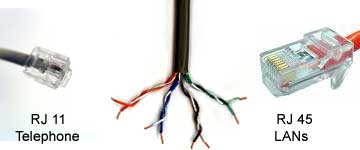![]() R. Craig Collins >
Common> How To Bandwidth
R. Craig Collins >
Common> How To Bandwidth
Bandwidth © R. Craig Collins, 2005
First, in order for items to be delivered, they need an address... computers have IP addresses, named for the protocol that most network traffic uses: TCP/IP.
These days even refrigerators have an IP address... but how long does it take for the message to get there?
A comparison that might help is: How long does it take to fill a kiddie pool with a garden hose with the spigot mostly closed? (Analog phone line, say.)
How long would it take to fill the same pool with a garden hose with the spigot opened all the way? (ISDN digital phone line, say.)
How about with a fire hose? (Broadband.)
Most would say the fire house, even though the water isn't moving any faster
than the garden hose; there is just more water being moved.

Bandwidth is the amount of information that can be moved across the Internet
in a given amount of time; usually measure in bits per second. Just as with
the garden hose vs. the fire hose, at some point you just can't move stuff any
faster... but you can move more of it at a time.
So bandwidth is less about speed (the transfer rate of an individual bit per second) than it is about quantity (the total number of bits transferred per second); the more you move, the faster it appears!
An analog phone line's 'speed' is measured from about 28 kilobits to 56 kilobits per second. A digital phone line can be about 128 kilobits per second. But most broadband connections all can move at about 1.544 megabits per second. What separates DSL from T1 and T3 broadband connections is the additional capacity... a T1 has perhaps the capacity of about 24 ISDN 'hoses' while a T3 has the capacity of perhaps 28 T1 'hoses.'
| Connection | Capacity | Time to download 3 MB | Time to download 30 MB |
| Dial Up | 14.4 to 56 Kb | 7 minutes to 31 minutes | 69 minutes to 5 hours |
| ISDN | ~128 Kb | 3 minutes | 30 minutes |
| DSL/Cable | 128 Kb~1.544 Mb | 37 seconds at 640Kb | 6 minutes at 640Kb |
| T1 | 1.544 Kb | 15 seconds | 2 minutes 30 seconds |
| Wireless LAN | to 10 Mb | 1 second | 24 seconds |
| T3 | 44.736 Mb | less than one second | 5 seconds |
| Wired LAN | 100 Mb | less than one second | 2 seconds |
| Fiber Optic | to 2.488 Gb | less than one second | less than one second |
Again, a lot of the bits travel about the same speed, but a T3 can move many more bits at a time, giving it a faster download time. FIber Optic does not have the 1.544 Mb limit, but rather is limited by how fast the sending device can put information into the network.
Note: LANs are fast at retrieving local data, but will limited to the Internet connection method speed for downloads.
Dial up Phone line (Cat 3 Twisted Pair) uses RJ11 connectors
Ethernet network line (Cat 5 or Cat 6 Twisted Pair) uses RJ45
connectors

Coax (coaxial) cable and connector

Fiber Optic cable (normally many cables bundled) and FDDI
connector
